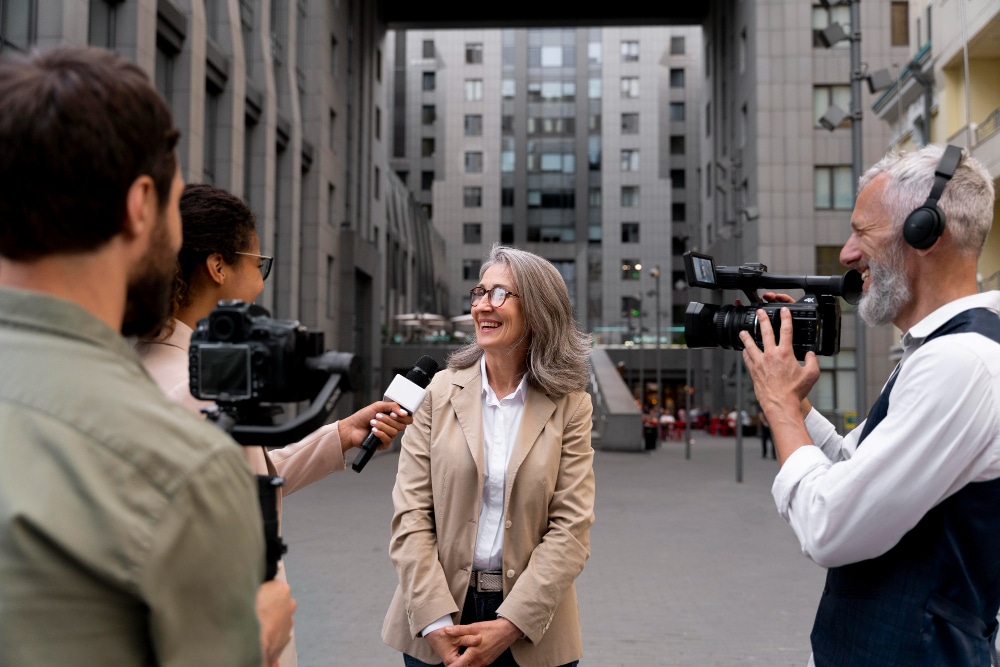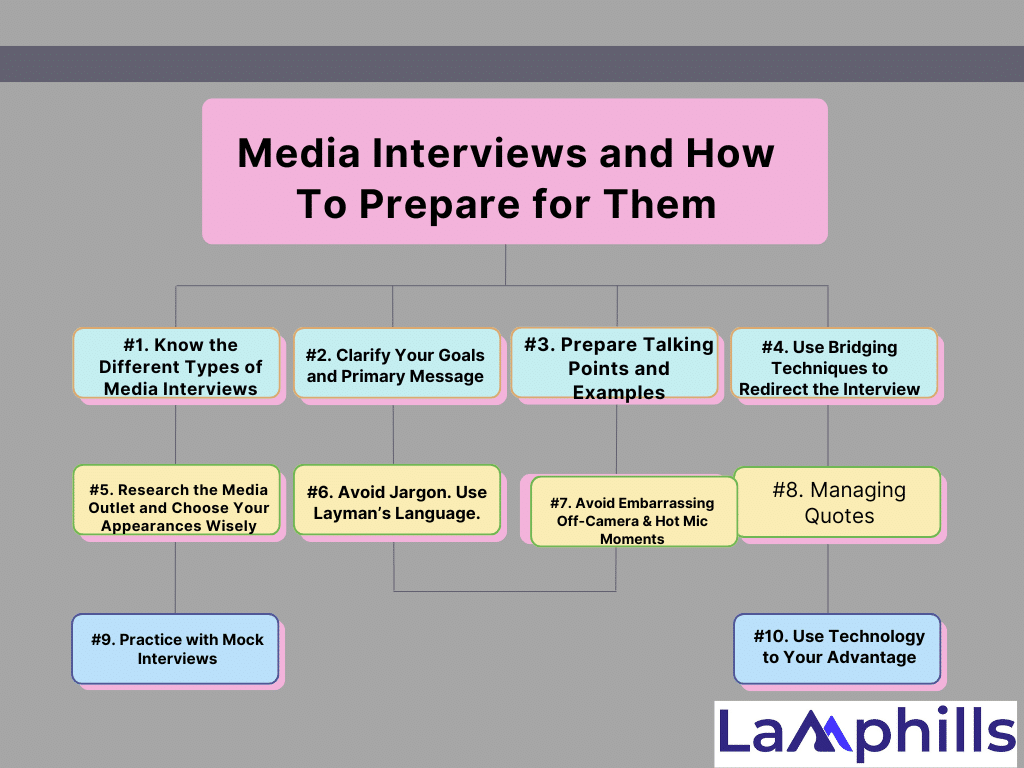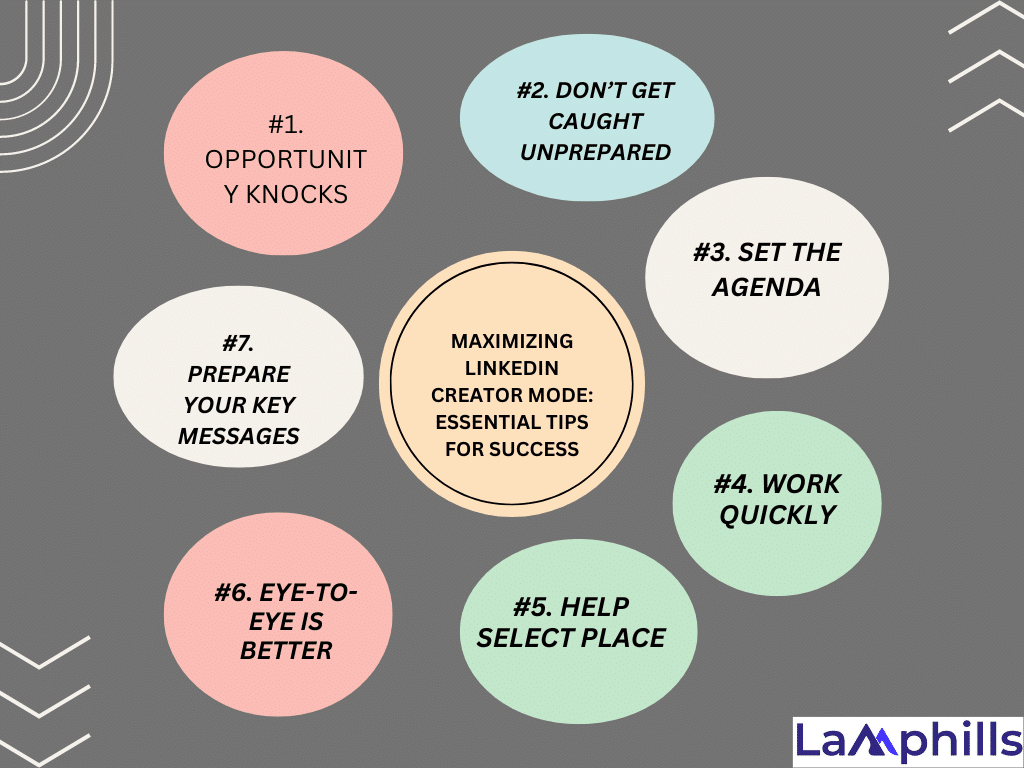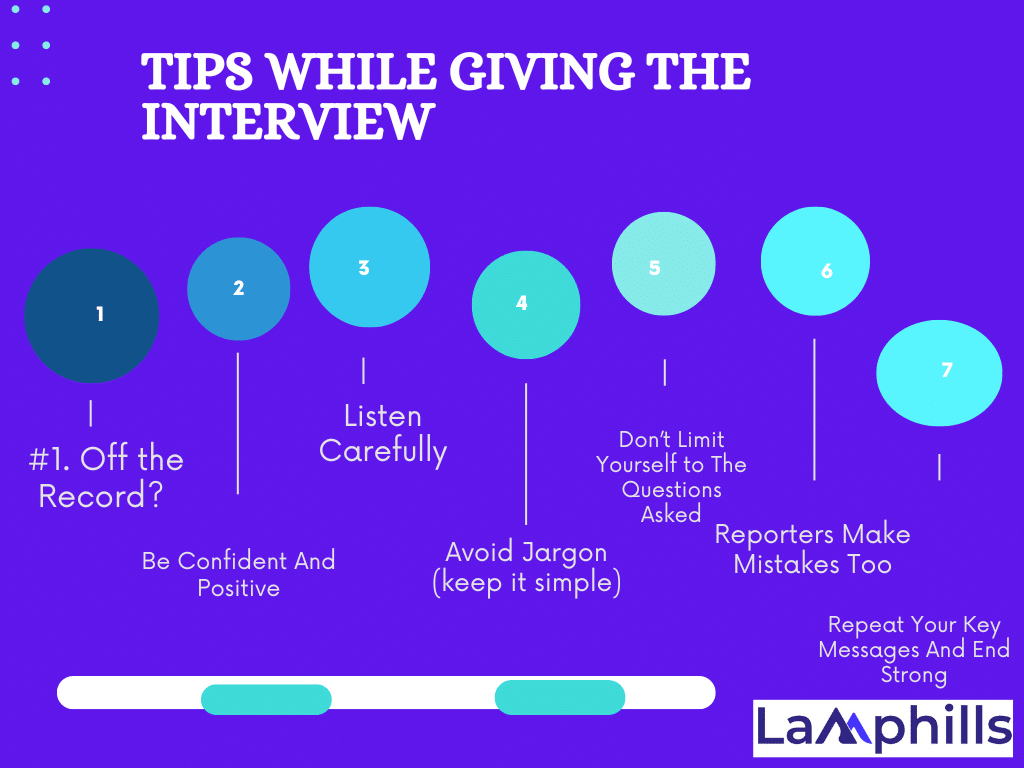Imagine standing in front of a camera, lights flashing, and an interviewer with a notebook ready to delve into your story. Sounds intimidating, right? However, media interviews provide an excellent opportunity to promote your business and grow your reputation. I remember well my first media interview—it was an outburst of emotions and excitement, but it taught me essential skills that I still apply today. In this article, I’ll explain how you can perform well in media interviews and leave a lasting impression.
Key Takeaways
- Being genuine and transparent in interviews helps build a real connection with your audience. For instance, Elon Musk’s candidness during his interviews, including the infamous podcast appearance where he smoked a joint, demonstrated his authenticity.
- Thorough preparation ensures you’re able to communicate your key messages clearly and effectively. Preparation involves knowing your goals, crafting clear talking points, and understanding the media outlet and audience.
- Simplifying complex ideas and avoiding jargon makes your message accessible to a broader audience. Steve Jobs was a master of this during his interviews with Walt Mossberg, where he explained Apple’s innovations in simple, relatable terms.
- Using bridging techniques, such as redirecting the conversation to your main points, helps keep the interview on track and ensure that your message is conveyed.
- Following up after the interview and reflecting on your performance can lead to improved future interactions and opportunities. Additionally, reviewing recordings of your interviews helps identify areas for improvement, ensuring that you continue to refine your messaging and delivery.
What is a Media Interview?

A media interview is a conversation that includes questions and responses for broadcast. This means sharing your expertise with the media is an effective approach to help the general public, government agencies, donors, and funders realize the significance of your research and the value of investing in current and future projects.
Media interviews are more than just presenting information; they help shape how others perceive you and your brand. A well-executed interview can help you establish yourself as an authority, gain credibility, and reach new audiences. Thinking about Elon Musk’s presence across numerous platforms. His interviews frequently result in major media coverage and conversation, strengthening his brand’s innovative image.
Similarly, journalists might ask you for your expert opinion on current events, or to spotlight your research or community outreach activities. Media interviews are a targeted technique to reach a large audience. When done correctly, media relations may help your startup flourish by raising brand recognition, enhancing credibility, developing strong media partnerships, and managing a crisis.
This is because the media setting is constantly changing, making it critical to execute techniques that link you to your audience. One of the most effective ways to accomplish so is to conduct media interviews with a large organization such as StartupLanes. Not only do they provide a platform to share your message, but they also help put a human connection to the brand.
Examples of Successful Media Interviews
Let’s take a look at a few examples of successful interviews.
#1: Elon Musk’s Appearances on Joe Rogan’s Podcast
Elon Musk, the CEO of Tesla and SpaceX, has made several memorable appearances on Joe Rogan’s podcast. These interviews are notable for their depth and the way they showcase Musk’s personality and vision. Now this is what made it successful:
- Authenticity: Musk’s interviews are marked by his genuine enthusiasm and candidness. He speaks openly about his ideas, struggles, and vision, which builds a strong connection with the audience.
- Engaging Content: The interviews are filled with fascinating insights into technology and space exploration, which captivate listeners and provoke thoughtful discussions.
- Visual Impact: During one appearance, Musk famously smoked a joint, which garnered widespread media attention. While controversial, it highlighted his willingness to push boundaries and be himself.
Lessons To Learn:
- Be Authentic: Authenticity resonates with audiences. Musk’s openness about his unconventional ideas and personal beliefs made the interviews engaging and memorable.
- Provide Value: Share valuable insights and perspectives. Musk’s deep knowledge and visionary ideas provided content that intrigued and educated listeners.
- Handle Controversy Gracefully: Even if an interview generates controversy, handling it with confidence and transparency can turn it into an opportunity for further engagement and discussion.
#2: Oprah Winfrey’s Interview with Meghan Markle and Prince Harry
In 2021, Oprah Winfrey interviewed Meghan Markle and Prince Harry in a highly anticipated and widely watched television special. The interview covered their experiences within the British royal family and their reasons for stepping back from royal duties. What Made It Successful:
- Preparation and Empathy: Oprah’s thorough preparation and empathetic approach allowed her to ask probing questions while making her guests feel comfortable and respected.
- Emotional Connection: The interview explored deeply personal topics, and Oprah’s skillful handling created an emotional connection that resonated with viewers around the world.
- Impactful Storytelling: The interview was structured to reveal key points gradually, maintaining viewer interest and maximizing the impact of each revelation.
Lessons Learned:
- Prepare Thoroughly: Being well-prepared allows you to ask insightful questions and handle complex topics with sensitivity.
- Create Comfort: Establishing a comfortable environment for your interviewee can lead to more open and honest conversations.
- Structure Your Content: Present information in a way that maintains engagement and builds towards impactful moments.
#3: Steve Jobs’ Interviews With Walt Mossberg
Steve Jobs, co-founder of Apple Inc., had several influential interviews with Walt Mossberg, a prominent technology journalist. These interviews often focused on Apple’s innovations and Jobs’ vision for the tech industry. Why was it successful:
- Clarity and Vision: Jobs was known for his clear and passionate articulation of Apple’s vision. His ability to explain complex technology in simple terms made his interviews highly effective.
- Confidence and charisma: Jobs’ confidence and charisma shone through in his interviews, making him a compelling and authoritative figure in technology.
- Focus on Innovation: The interviews highlighted Apple’s groundbreaking innovations, reinforcing Jobs’ reputation as a visionary leader.
Lessons Learned:
- Communicate Clearly: Break down complex ideas into understandable and relatable terms. Jobs’ clarity in explaining Apple’s technology made his messages accessible and impactful.
- Show confidence: Confidence in your message and delivery can enhance your credibility and influence.
- Highlight Your Strengths: Focus on showcasing your unique contributions and innovations. Jobs’ emphasis on Apple’s innovations reinforced the brand’s leadership in the industry.
Media Interviews and How To Prepare For Them

Businesses have a fantastic opportunity to get their name in front of millions of people; whether you’re engaging with a new audience or reconnecting with old followers, media interviews are an excellent approach to promoting your message while increasing credibility and authority. Interviews may not be used to explicitly market a product or service, but they do provide insight and value into who you are and what you do.
This is another reason why the interview should be viewed as a messaging platform rather than a sales opportunity. However, if you are unfamiliar with media interviews, do not panic; I have you covered. Remember that you are always on the record when conducting an interview. Anything you say to a reporter might end up utilized in a published work, thus it is critical to follow the procedures below to prepare for any media contact. Here are some interview basics to keep in mind while preparing:
#1. Know the Different Types of Media Interviews
As technology advanced, so did the platforms where you might be invited to be interviewed. Online video platforms (think live social media interviews) are becoming more popular. Live television or radio interviews, however, remain the most sought-after kind of media appearance.
You may be invited to the studio to conduct the interview, or you may be recorded live from home. Naturally, not all media interviews are conducted live. Journalists from content-driven media publications (online-only or hybrid, such as a national print newspaper) may also seek your skills.
#2. Clarify Your Goals and Primary Message
Effective interviews require clear, memorable statements. Think of the main themes you want to convey and practice expressing them clearly. For example, if your primary message is about your company’s commitment to sustainability, prepare a few intriguing figures and tales to support it. During an interview with a national publication, I discussed how our eco-friendly activities were having a concrete impact, which struck a chord with their audience.
Your interviewer will have particular objectives for the interview. But think about it: what are your goals? Expand your business? Clarify your organization’s position, possibly on a challenging topic. Establish yourself as a thought leader in a given area. Increase consumer buy-in for your goods. Encouraging or influencing investor funding?
Trust me, clarifying your goals is the first and most important step to having a successful interview. Once you’ve got that piece covered, it’s time to craft your message, which needs to align with your goals. Get your goals and messaging right and you’ll have no trouble showing up as the focused, organized expert you are (and not a rambling, off-tangent interviewee!)
#3. Prepare Talking Points and Examples
You are being interviewed because of your extensive understanding of the subject matter. Make your own experience clear by preparing three to five precise essential topics to discuss during the interview. Use a story or example to illustrate each talking point—this will help your interview come to life and stand out. Taking the time to pick rich highlights that create a whole image is always a valuable investment of time.
For each of your primary points, use the context, problem, solution, and benefit (CPSB) framework to keep your message clear and succinct. Find a nice medium between not offering enough description (being ambiguous) and too much detail (which might bore your audience). If the interviewer wants more detail, they’ll ask for it.
#4. Use Bridging Techniques to Redirect the Interview
Here is a secret. The interviewer can ask questions, but you can also influence the interview. You agreed to participate in the interview to express your perspective. If you believe the line of questioning is getting off track, simply use what communication professionals call “bridging” to return the subject back to your talking points.
“Bridging” entails deliberately using transitional phrases to gently steer the interview back to your goals. Here are some examples of bridge statements to use:
- “That’s a great question, but I want our viewers to know that…”
- “I’d like to finish my point before we continue…”
- “That’s interesting, but out of the scope of my expertise. Here is what I know…”
Using these types of phrases to redirect the conversation back to your talking points opens up the opportunity to speak about what you know.
#5. Research the Media Outlet and Choose Your Appearances Wisely
Before beginning any interview, it is critical to understand who you will be speaking with and their audience. I once had an interview with a niche industry publication, and understanding their specific readership helped me to customize my responses to their preferences. Researching the media outlet will help you fit your message with their style and audience expectations.
If your goals and those of the media outlet are compatible, you may not need to employ bridging at all. Choose who you invite to interview you carefully.
Prepare by researching the journalist and media source ahead of time. Will the interviewer offer a balanced view? Is being interviewed by this specific media outlet/interviewer a good use of your time? Is your target audience listening or watching? to the media channel?
You should not expect a reporter to make things easy for you, but you also do not want to be subjected to biased reporting. (That being said, if you have the skills to hold your own during a tough interview, it is an opportunity to showcase what you know and demonstrate your ability to back up your claims.)
#6. Avoid Jargon. Use Layman’s Language
As specialists, we frequently forget that our audience does not grasp industry jargon. Your audience should comprehend what you’re saying without having to look at their phone for a translation. Someone once remarked, “Everything should be made as simple as possible, but not any simpler.” (Perhaps Einstein said it? But even if not, it’s still sound counsel.)
A true expert can teach what they know to almost anyone. As you design your talking points, make sure they are as simple as feasible. Don’t go into detailed explanations unless you’re asked to. Media appearances, like any other type of communication, are always about the audience.
understanding you. It’s not about you, it’s about them. Only use industry jargon if the audience is solely comprised of your industry peers—which, for a media interview, is rare.
#7. Avoid Embarrassing Off-Camera & Hot Mic Moments
Anything you say is fair game. Yes, everything. Even if you request that information be kept confidential, there is no guarantee that it will not be used. So, play it safe. Don’t mention anything you don’t want to be made public. Some of the most experienced, high-profile individuals have been caught unexpectedly with their microphone on—with a “hot mic.” Don’t say anything you don’t want to repeat until you’re alone at home or with trustworthy coworkers. Even if your microphone is turned off, you never know who might be listening.
But what happens if you reveal something you shouldn’t?
Perhaps you revealed information that you thought was already public, but it wasn’t. Or perhaps you overestimated your experience. Of course, if the interview was live, you’re out of luck.
However, if it is not live, you have other possibilities. Don’t be afraid to ask that the information be removed from the tape and not used. Explain what the consequences might be. You could offer to return with updated information.
Trust me when I say that working in the media is all about relationships. Building solid media contacts before the interview (and before every interview) increases your chances of receiving a “yes” when you need to request a Hail Mary pass.
#8. Managing Quotes
During a phone interview, ask the interviewer to repeat your quotes (they may offer, but it is also your right to ask). This guarantees that your quote is accurate. Journalists will occasionally email you a draft of your quotes to guarantee correctness. However, it depends on the journalist, so don’t bet on it. Again, it is acceptable to inquire, but don’t expect that kindness.
To be honest, the best way to avoid being misquoted by the media is to speak clearly and accurately because corrections or retractions are not guaranteed.
woman reading a newspaper with a distressed expression after finding out she was misquoted. Even if corrections are given, what people remember is what was stated first, not the correction itself.
#9. Practice With Mock Interviews
I’ve never had a client tell me that they wished they had practiced less. Media interview practice is frequently left too late, and the results might be less-than-ideal.
Practicing requires commitment and a desire to do well in interviews. If you have a busy schedule, do yourself a favor and schedule practice time. learning’s worth learning for the confidence you’ll have when answering inquiries.
Mock interviews are a great method to prepare. But be careful who you invite to your fake interview sessions. A coworker with minimal experience may provide comments from a biased perspective, which may not be what your audience needs to know or hear. Instead, ask seasoned peers with media experience, or someone from your PR department, or call in a communication specialist to provide sound advice.
#10. Use Technology to Your Advantage
Being prepared includes knowing what to expect in a professional IT setting. Large media outlets will have someone on hand to assist you. They will assist you in attaching your microphone and setting up the studio lighting. Make sure not to brush your hand against the microphone with hand gestures.
One common mistake I see newcomers do when interviewing is looking into the camera, which looks weird. You are better benefitted by engaging in genuine conversation and, therefore glance at the interviewer.
If you’re being questioned by your company or home office, invest in the best technology you can afford. Make sure you’re well-lit and your audio quality is clear. Good quality equipment is affordable and it’s worth the investment to make you look and sound good.
My Tips For Giving a Media Interview
Media interviews present an opportunity to communicate with a large audience. It is a chance to present your messages and the information you believe the public needs to hear. here are additional tips you can implement beforehand to ensure your next media interview is a success.
Before the interview

#1. Opportunity knocks
When a reporter calls for an interview, first determine the best person to give the interview (ideally you will have identified a media spokesperson already). Give that person time to get prepared. This is an opportunity to get your message out. Develop a strategy with a set of goals of what you would like to accomplish in giving the interview and the key messages the spokesperson will focus on.
#2. Don’t Get Caught Unprepared
Don’t take on “cold interviews” like the phone call at 8:30 a.m. when you haven’t even had time to hang up your coat. If you are cold-called, get preliminary information from the reporter: Once you have this information, thank the reporter and tell them you will get back to them.
#3. Set The Agenda
Define your area of expertise before the interview starts so that you’re certain the story will coincide with your ability to comment effectively. Establish any limits to your expertise upfront.
#4. Work Quickly
Some issues are more urgent than others, and reporters may be on a tight deadline. Speed in getting out the appropriate statement often matters as much, or more, as what you say. But make sure you still take the time to mentally prepare. Remember that everything follows from your first statement, so it must hold up under scrutiny. Please if possible, schedule the interview for a time that’s convenient for you. Ask about deadlines and be prepared to negotiate. Return media calls as quickly as possible.
#5. Help Select Place
If it’s an in-person interview, you should have some input on where it will be held—inside, outside, at your desk, standing, sitting, etc. Your comfort level is the issue. But be aware that the cameraperson and reporter have limitations imposed by technology. They can’t shoot you with your back to a window because of the lighting problems. But if you do some research, you should be able to have credible input as to where the interview takes place. These things can be negotiated.
#6. Eye-to-Eye is Better
It isn’t always possible, but try to be interviewed in person (as opposed to by phone). Research has shown these stories tend to be more accurate. It also allows you to give the reporter your facts and figures, key messages, etc., in written form (i.e. media releases, background papers, briefing notes, journal articles, or statistics).
#7. Prepare Your Key Messages
The media interview is an opportunity to tell your organization’s position in the issue, which you should have summarized in a few key messages. You should try to insert these into the interview at every appropriate moment:
- Research your facts
- Develop your main message (see pages 2 and 3)
- Anticipate questions and responses
- Rehearse your responses
Giving the interview

#1. Off the Record?
There’s no such thing so avoid it. Sometimes off-the-record backgrounder sessions are requested by the reporter, but you must still be very careful in these situations. The information has a way of surfacing in unexpected ways. Reporters are under no obligation to respect “off-the-record” information. If you don’t know an answer, say so. Promise to get an answer for the reporter if it’s at all possible. Always avoid using the phrase “No comment.”
#2. Be Confident And Positive
Speak in simple, clear sentences. Always keep your goals and key messages in mind. You’re the expert now. Then avoid being rude, hostile, or confrontational with a reporter. This detracts from your message. As Mark Twain once said: “Never argue with someone who buys ink by the barrel.”
#3. Listen Carefully
This may seem obvious, but sometimes people get so anxious, that they don’t listen to what is being asked. Taking some notes during the questions can help. Condense your answers: This is especially helpful in TV and radio interviews where they look for summary answers that fit into taped reports—the so-called 15-second sound bite. This also works in print interviews because it helps you to focus on your goals and key points.
#4. Avoid Jargon (keep it simple)
Journalists are usually not very well informed on what you do or who you represent. So, keep it simple without talking down to them. Academia already has a reputation for making simple things unnecessarily complex—here is an opportunity for you to demonstrate that you can communicate clearly.
#5. Don’t Limit Yourself to The Questions Asked
To get your key messages in you may have to turn a question or two around, or ignore the question entirely. It can be tempting to try to answer every question, but that approach will get you into trouble. Your goal in every interview is to make sure your organization’s position is reflected in the story, so stay focused on answering questions in ways that emphasize your key message.
Sometimes the question may seem loaded or you may disagree with the premise. In these cases, you can pivot. For example, you might say: “I think the main issue here is …” or “I don’t think that’s the main point.” Regardless of the question, try to find ways to bring it back to one of your key messages.
#6. Reporters Make Mistakes Too
Reporters, particularly young ones, often make the mistake of asking two questions at the same time. In this case, answer the question you like better. Don’t feel obligated to do the reporter’s job for them.
#7. Repeat Your Key Messages And End Strong
At the end of the interview, summarize for the reporter. Be straightforward if you like. “The main points I hope you got out of this interview with me are….”Avoid trailing off at the end of your answers. Try to bring every answer back to one of your key messages and come to a confident conclusion.
After the interview
- Most reporters won’t let you see or read the story before it is printed or broadcast. Often, they can’t tell you when it will be printed, although most TV and radio reporters are working for broadcasts that same day.
- It is permissible to ask the interviewer if they made note of certain points you were trying to get across during the interview. It is also OK to call afterward and, in a friendly way, ask for a review of the story. Many reporters will be obliging and may even read parts of a story for you.
- You may also call the reporter with further information or clarification, especially if the interview left you uneasy in some way or if new and relevant information has come to your attention.
- After the interview, send a thank-you note to the interviewer. It’s a professional courtesy that can also open doors for future opportunities. I’ve found that following up positively after interviews often leads to additional coverage or networking opportunities.
- Reflect on the interview to identify what went well and what could be improved. Reviewing recordings of your interviews can provide valuable insights. I’ve used feedback from past interviews to refine my messaging and delivery for future appearances.
- Once the interview is live, share it across your social media channels and website. Highlight key quotes or insights to draw attention. When I was featured in a major industry publication, I promoted the interview on LinkedIn and Twitter, which significantly boosted its reach and engagement.
What Are the Benefits of Media Interviews?
- Sales: People will get to know about your business offerings, and then they will buy from your business.
- Awareness: People will get to know about your business and the products/services offered by your business.
- Credibility: You can build your credibility through the media interview.
How to Get Media Interviews?
You are going to have to contact the producers and editors of the media outlets that you want interviews with, which means that you are going to have to write a pitch for them.
What Is the Purpose of a Journalist Interview?
The journalistic interview is a highly important genre in journalism, serving as a key method for acquiring information and conducting in-depth conversations with individuals.
How Long Is a Media Interview?
Most print media interviews last about 20 minutes, and for TV they can be much, much shorter. You might only get a quick quote or sound bite. So make sure you can state your message concisely and clearly.
Conclusion
Media interviews offer a powerful platform to amplify your brand and establish yourself as a thought leader. By reflecting on successful interviews and applying the strategies outlined above, you will come out with confidence and impact.
As you prepare for your next media interview, remember that it’s not just about conveying information but also about shaping perceptions and building connections. So, take a deep breath, trust in your preparation, and step into the spotlight with confidence. Your next media interview could be the moment that propels your brand to new heights and cements your reputation as a leader in your field.





